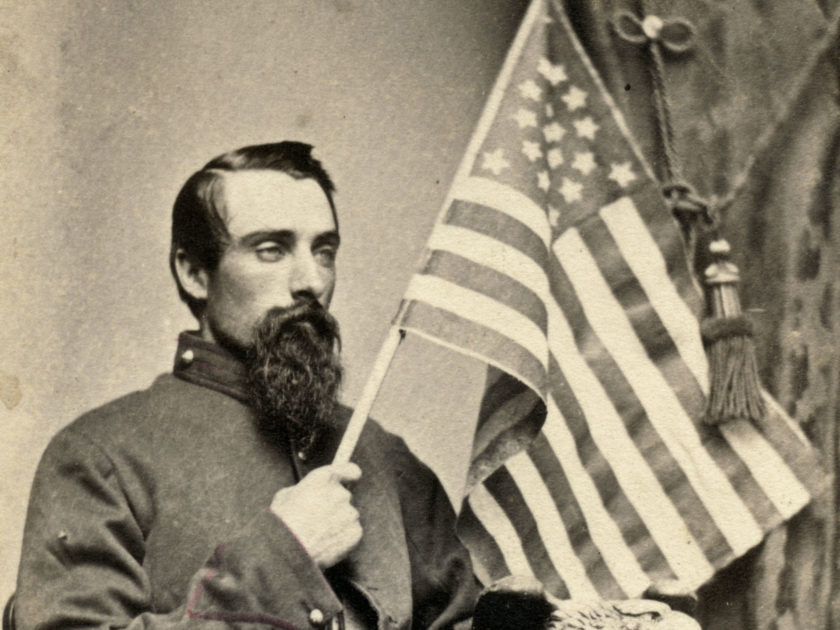The first time Ronn Palm visited the red brick row house on 229 Baltimore Street in Gettysburg, Pa., the prominent archway in the entrance captured his attention. “Holy hell,” he though to himself, as the graceful shape of the building reminded him of a page in a carte de visite album.
“That’s how my mind works, you know,” Palm said as he discussed the origins of the museum that bears his name.
During his childhood in the Pittsburgh suburb of McKeesport, Pa., Palm collected baseball cards and coins, and when he was old enough to drive became a regular at coin shows. He noticed Civil War relics at some of these events, though it was not until the early 1970s that he found his passion as a photo collector. His special interest became Pennsylvania Bucktail regiments.
Palm recalls that he saw an ad for Civil War memorabilia in Shotgun News in the early 1970s. He recognized the telephone number as a local exchange and dialled. Soon thereafter, he was face-to-face with Mike Woshner. “Mike asks me what I collect, and he shows me all these relics, dug stuff. Then I looked into a case and saw something shiny. It’s a picture, an ambrotype, for $1.25. That’s how it started.”
Woshner has remained a close friend. They still joke about that first purchase. “You overcharged me!” Palm laughs. “It’s about the relationships,” Palm observes about his many collector friends, “All the people I met are the closest friends I ever had in my life. Better than friends at school.”
With the help of his friends, Palm amassed thousands of images. That’s right. Thousands. They might have remained tucked away in albums, but a home remodelling project ended in a realization that he didn’t have the space in his den to display his collection the way he wanted. “I’m going to get a place in Gettysburg and open a museum,” Palm decided, as simple as that. And he did. In 1997, he purchased the Baltimore Street row house. It dates to December 1801 and is the second oldest surviving structure in Gettysburg’s historic district.
He spent three years prepping the building. Ronn Palm’s Museum of Civil War Images opened one day in June 2000. Palm recounts, “I wanted to get it open for the Civil War show and my friends coming in town. Never really had an opening. People just started showing up.”
And, they still do. You won’t find interpretive plaques or other written materials. Palm doesn’t need them. He thrives on the personal interactions and the opportunity to make new friends—and just maybe connect them to their long lost Civil War ancestor.
Not long ago, a family stopped by the museum. One of the children, a boy, was especially interested in the old photos. He had questions, and Palm answered them. The boy purchased a tintype from the antique case full of sale items. Maybe he will become a collector.
Palm remains a collector. “Sometimes you wanna think you’re doing something that makes these guys happy that you’re trying to honor them,” he explained. “Getting an image is great. But identifying an image. That’s my high.”
Tough Going on the Virginia Peninsula

The Peninsula Campaign was hard on 19-year-old Willis Townsend Benedict, a private in Company G of the 62nd Pennsylvania Infantry. Wounded in the eye at Gaines’ Mill and captured at Malvern Hill, he spent several months in confinement at Libby Prison and Belle Isle. Discharged for disability in December 1863, he returned to his farm in Crawford County, Pa., married, and started a family that grew to include seven children. He lived until age 79, dying in 1922 of heart disease.
An Artful Pose

The photographer who captured this federal light artilleryman deserves high marks for artistry. The placement of the dress sword, revolver and draped flag perfectly frame the young citizen soldier engrossed in a military manual. His crossed leg creates a right angle to the sword, and his hat with the crossed cannons completes the portrait.
A Militiaman

At first glance, this soldier might be recognized as a Confederate dressed in a battleshirt and light-colored cap. Upon closer inspection, however, the American flag pin on his cap and the US waist belt buckle reveal his Northern loyalties. He is an unidentified early war Pennsylvania militiaman.
Guard Against Cavalry

An unidentified private in the 19th Indiana Infantry holds his Enfield rifle musket in what appears to be a defensive posture. He may be demonstrating the Guard against Cavalry drill position from the 1863 U.S. Infantry Tactics manual. The 19th served in the Iron Brigade of the Army of the Potomac.
A Photographer in the Field
 Taking a spoonful of food from his tin cup, the quarters in which this Union soldier sits gives every indication that he is a field photographer in a makeshift studio. On the right, an assortment of brass mats hang from pegs on the wall, below a shelf upon which appears to be stacked cases and more mats. Bottles and a small wood box lay against the back wall behind his camp chair. On the left, a bunk and a sign with the initials B, F and C is clearly visible. The ceiling looks as if composed of canvas.
Taking a spoonful of food from his tin cup, the quarters in which this Union soldier sits gives every indication that he is a field photographer in a makeshift studio. On the right, an assortment of brass mats hang from pegs on the wall, below a shelf upon which appears to be stacked cases and more mats. Bottles and a small wood box lay against the back wall behind his camp chair. On the left, a bunk and a sign with the initials B, F and C is clearly visible. The ceiling looks as if composed of canvas.
Dranesville Hero
 In the spring of 1861, Francis M. Peters numbered among the first responders after war divided the country. He enlisted as a private in Battery A of the 1st Pennsylvania Light Artillery, and was later recognized for gallant conduct during the Battle of Dranesville, Va., on Dec. 20, 1861. He is pictured in this early war portrait with the Stars and Stripes and an eagle statue. The 1st went on to participate in several major battles in 1862, including Second Bull Run, South Mountain, Antietam and Fredericksburg. Battery A spent the majority of the rest of the war in southeast Virginia. Peters mustered out in May 1864.
In the spring of 1861, Francis M. Peters numbered among the first responders after war divided the country. He enlisted as a private in Battery A of the 1st Pennsylvania Light Artillery, and was later recognized for gallant conduct during the Battle of Dranesville, Va., on Dec. 20, 1861. He is pictured in this early war portrait with the Stars and Stripes and an eagle statue. The 1st went on to participate in several major battles in 1862, including Second Bull Run, South Mountain, Antietam and Fredericksburg. Battery A spent the majority of the rest of the war in southeast Virginia. Peters mustered out in May 1864.
Tribute to a Fallen Hero
 The dramatic murder of Col. Elmer E. Ellsworth, shot dead after he hauled down a Confederate flag from a tavern in Alexandria, Va., in May 1861, prompted anger and indignation from the Northern populace. His martyrdom spurred a tidal wave of patriotism that manifested itself in many forms, most notably the organization of the People’s Ellsworth Regiment, which mustered for federal service as the 44th New York Infantry. Among the lesser-known tributes is this custom doll, complete with colonel’s shoulder straps and cap.
The dramatic murder of Col. Elmer E. Ellsworth, shot dead after he hauled down a Confederate flag from a tavern in Alexandria, Va., in May 1861, prompted anger and indignation from the Northern populace. His martyrdom spurred a tidal wave of patriotism that manifested itself in many forms, most notably the organization of the People’s Ellsworth Regiment, which mustered for federal service as the 44th New York Infantry. Among the lesser-known tributes is this custom doll, complete with colonel’s shoulder straps and cap.
The Spirit of ‘61
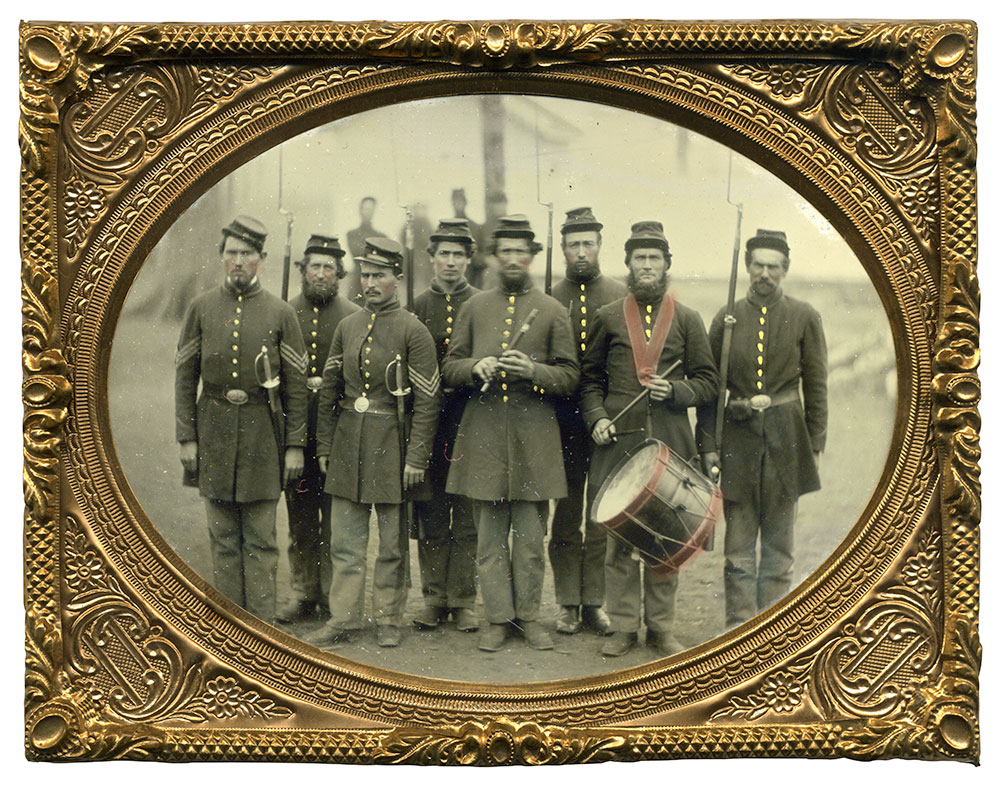
A Union drummer and fifer are surrounded by a pair of sergeants and a quartet of enlisted men. The musician’s swords carried by the sergeants are noteworthy. In the absence of proper shoulder slings to carry the swords, the men impovised. They turned their scabbards around and slid the prong on the brass throat over their waist belts. This has caused the swords to sit too high. A rock wall and large building in the background suggest this image was taken on the outskirts of a town.
Pea Ridge Participant
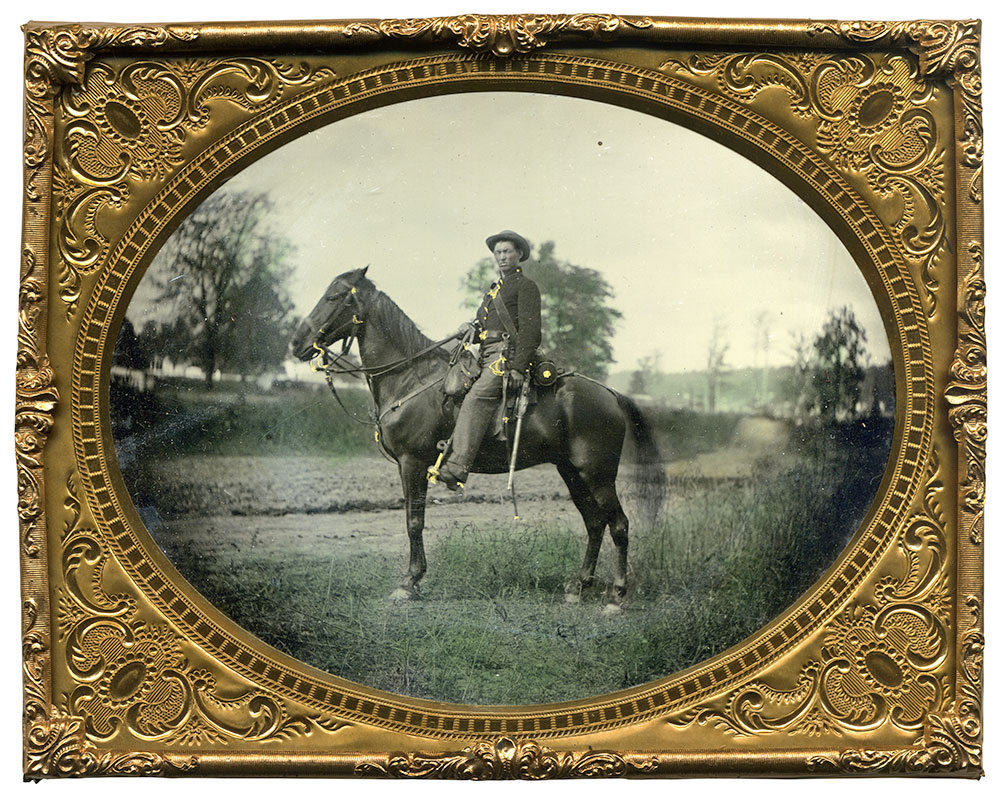 The men of the 3rd Illinois Cavalry participated in their first major engagement at Pea Ridge, Ark., March 6-8, 1862. Their number incuded Martin L. Treadway, who had enlisted as a private when the regiment formed the previous summer. He poses here on his fully equipped mount complete with a carbine hanging from the saddle. Treadway survived Pea Ridge and the rest of the war, and mustered out as a corporal in Company F in October 1865. A native of Beardstown, Ill., he died there in 1910 at age 70. His wife and a son survived him.
The men of the 3rd Illinois Cavalry participated in their first major engagement at Pea Ridge, Ark., March 6-8, 1862. Their number incuded Martin L. Treadway, who had enlisted as a private when the regiment formed the previous summer. He poses here on his fully equipped mount complete with a carbine hanging from the saddle. Treadway survived Pea Ridge and the rest of the war, and mustered out as a corporal in Company F in October 1865. A native of Beardstown, Ill., he died there in 1910 at age 70. His wife and a son survived him.
A Personalized Accouterment
 One clue to establishing the identity of this federal is the richly painted canvas backdrop depicting rows of tents and a mountainous background. The artwork may be tracable to other images of identified soldiers and known regiments. The most prominent clue however is easy to miss—his rifle sling, which appears to read H.G.F. Co. K 152nd. This may be Henry Forshey, who served as a private and corporal in Company K of the 3rd Pennsylvania Heavy Artillery (152nd Pennsylvania Regiment) from 1864-1865. Forshey survived the war and died in 1934.
One clue to establishing the identity of this federal is the richly painted canvas backdrop depicting rows of tents and a mountainous background. The artwork may be tracable to other images of identified soldiers and known regiments. The most prominent clue however is easy to miss—his rifle sling, which appears to read H.G.F. Co. K 152nd. This may be Henry Forshey, who served as a private and corporal in Company K of the 3rd Pennsylvania Heavy Artillery (152nd Pennsylvania Regiment) from 1864-1865. Forshey survived the war and died in 1934.
Ready for Rainy Weather
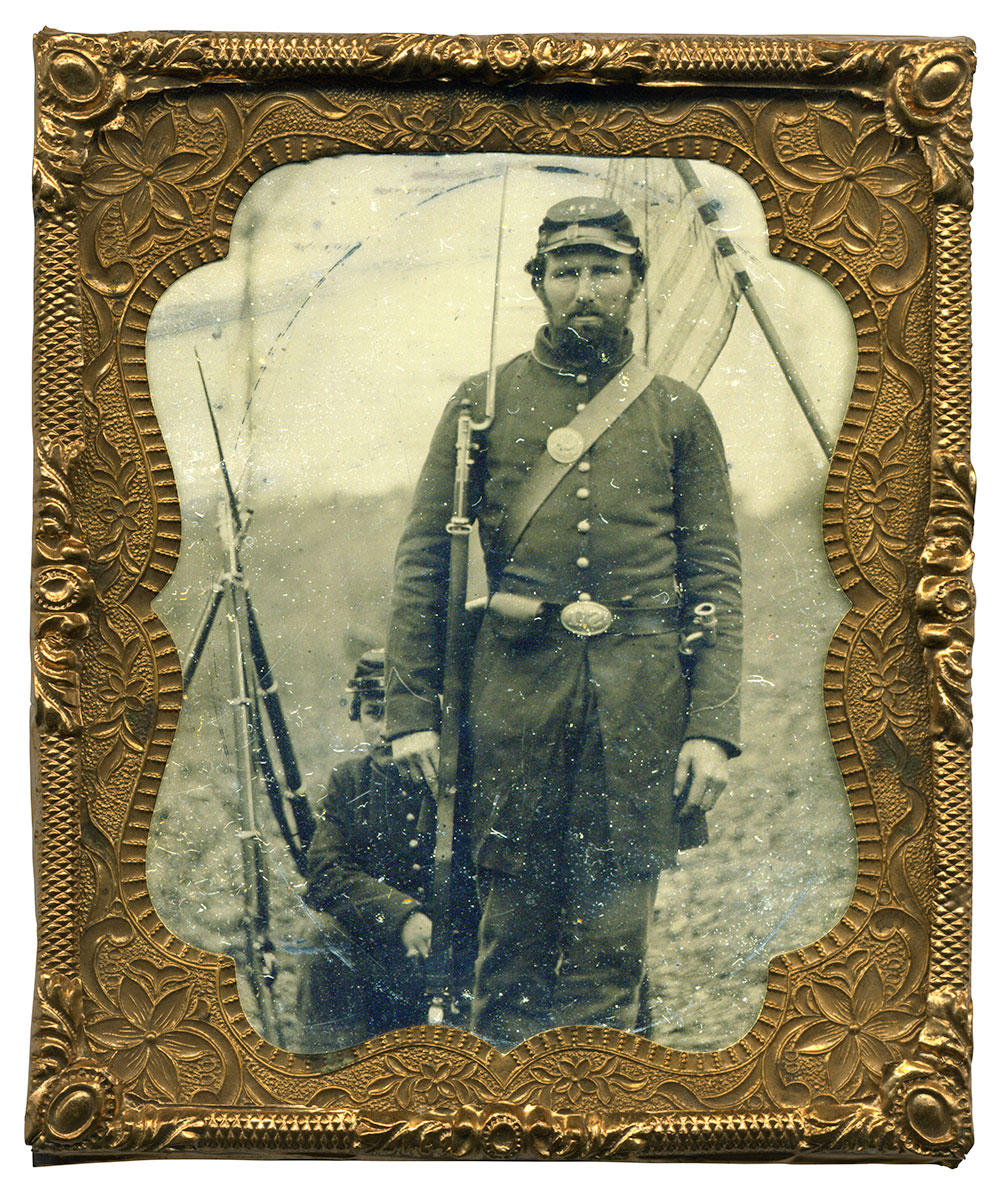
Though infantrymen were issued wood tompions to prevent water and debris from entering the muzzles of their weapons, they are rarely pictured in use. The round top of the tompion for the Enfield rifle musket held by this private is clearly visible. More common is the upside-down belt buckle, which was done by the soldier in an atempt to compensate for the reversed effect of tintypes during this period. The boy seated next to the stand of weapons may be a drummer.
Wounded in the Summer of 1864

Among the new recruits that arrived in the camp of the veteran 55th Pennsylvania Infantry in early 1864 was Henry Ickes Claar. A farm boy from Bedford County, Pa., he mustered into Company K as a private on March 2. Attached to the Army of the James in Virginia, the 55th participated in operations around Petersburg and Richmond, including Drewry’s Bluff, Cold Harbor and New Market Heights. Claar shows off a wound he received during the course of action. Though the bandage hides the injury, someone, perhaps Claar, inked in a thick line across the top of his foot. It may indicate the path of a bullet or shell fragment. More ink, artfully added from the line to his toes, suggest a trail of blood that streamed from the wound. Claar recovered and mustered out with his comrades in August 1865. He and his wife, whom he had married in September 1864 during his recuperation, became parents to 10 children that lived to maturity. Claar died at age 76 in 1919.
Three “Heavies” Ready for Action
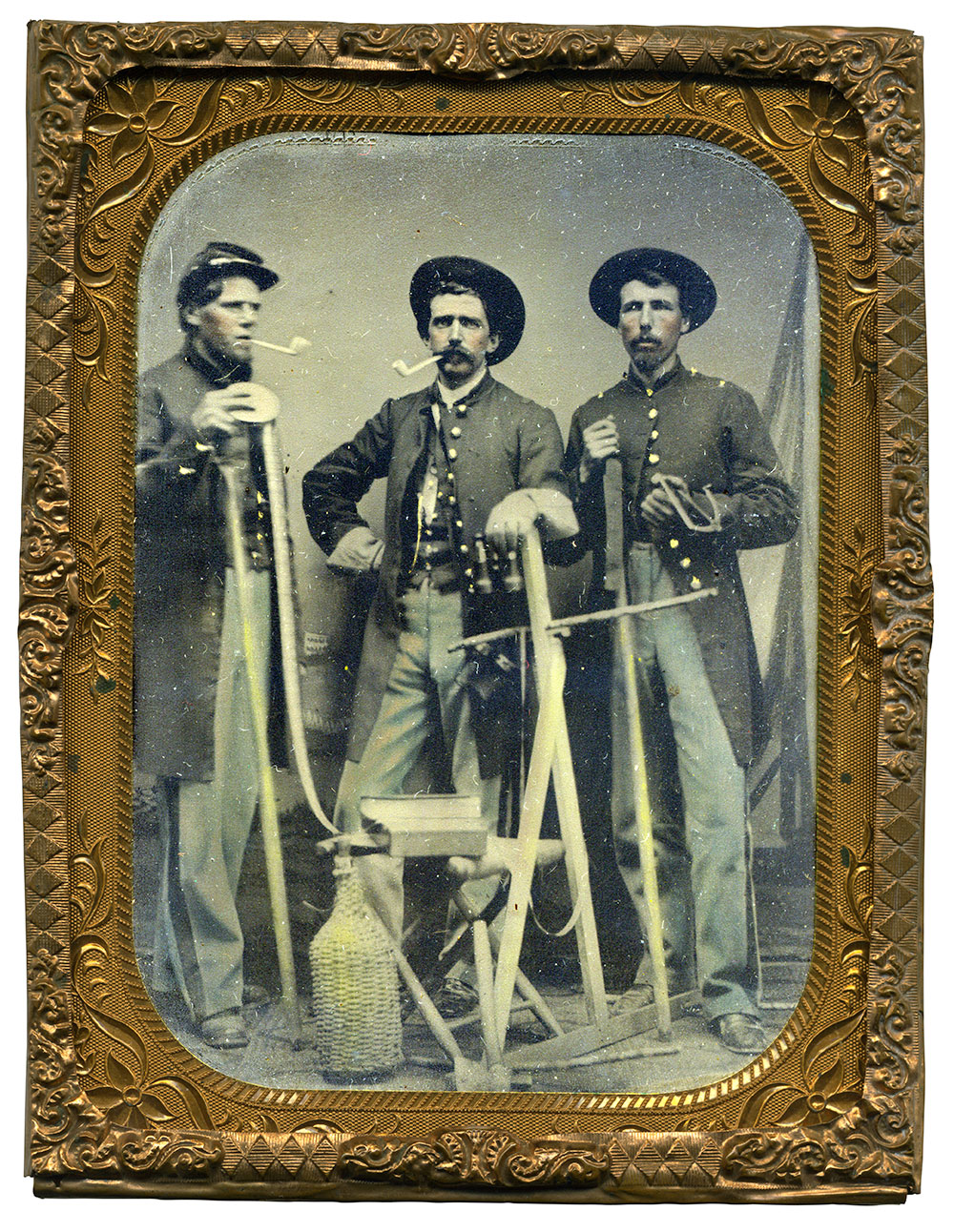
A trio from Company A of the 10th New York Heavy Artillery pose with the implements used in their branch of the service, including field glasses, a quadrant, a hand spike, an ax and a t-square. Also included are the pleasures of camp life—ever present pipes and a wicker-covered bottle of spirits.
Sgt. George Porter Jr., left, enlisted in August 1862. When the regiment mustered at Petersburg, Va., in May 1865, he was transferred to the 6th New York Heavy Artillery to complete his three-year term. He died of disease a month later.
Second Lt. Addison Dwight Richards, center, began his service in 1861 with the 7th New York Cavalry, and joined the 10th in the summer of 1862. He survived the war and settled in Pittsburgh, where he died in 1906. His wife and a daughter survived him.
Cpl. Henry D. Payne, right, enlisted in 1862 and advanced to second lieutenant in April 1865. He was transferred to the 6th New York Heavy Artillery and mustered out in August 1865. Payne returned to Watertown, N.Y., and served on the committee of veterans who approved the regimental history prior to its publication in 1887. He died in 1916.
The men posed for this portrait about September 1863 when they were at Fort Baker in the defenses of Washington. In March 1864, they and many other of the “Heavies” left the capital for field duty with the Army of the Shenandoah and the Army of the James.
At Rest in the Field
 Union cavalrymen take a break from their regular duties to pose for their portrait on what appears to be an autumn day. The rectangular waist belt plate worn by the soldier standing on the right indicates he ranked as a non-commissioned officer though he does not wear chevrons on his coat sleeves. Images of this genre—informal, environmental and centered on the citizen soldier—are representative of the democratization of photography that individualized the identity of the American fighting man.
Union cavalrymen take a break from their regular duties to pose for their portrait on what appears to be an autumn day. The rectangular waist belt plate worn by the soldier standing on the right indicates he ranked as a non-commissioned officer though he does not wear chevrons on his coat sleeves. Images of this genre—informal, environmental and centered on the citizen soldier—are representative of the democratization of photography that individualized the identity of the American fighting man.
In the Provost at Gettysburg
 During the Battle of Gettysburg, the 2nd Pennsylvania Cavalry was attached to the provost guard at the headquarters of Maj. Gen. George G. Meade. The Pennsylvanians, 575 sabers strong, included Pvt. Andrew Sullenberger, pictured here in three separate portraits. He is seated, left, upon his trusted mount before what may be a barber shop, judging from the pair of striped poles that flank the entrance. Sullenberger holds a company guidon in one hand and the reigns of his horse in the other. He wears the Pascall Havelock hat issued to the several Pennsylvania cavalry regiments. Though comfortable, those who wore the hat generally found them unattractive. The cap is present in the other two studio portraits in which Sullenberger sits with various weapons. He survived the war and returned to his home in Lancaster County, Pa. Sullenberger and his wife raised four children that lived to adulthood. He worked in a stone quarry to provide for them. A quarry accident about 1887 blinded him, and he qualified for a military pension that he received from 1890 until his death in 1904.
During the Battle of Gettysburg, the 2nd Pennsylvania Cavalry was attached to the provost guard at the headquarters of Maj. Gen. George G. Meade. The Pennsylvanians, 575 sabers strong, included Pvt. Andrew Sullenberger, pictured here in three separate portraits. He is seated, left, upon his trusted mount before what may be a barber shop, judging from the pair of striped poles that flank the entrance. Sullenberger holds a company guidon in one hand and the reigns of his horse in the other. He wears the Pascall Havelock hat issued to the several Pennsylvania cavalry regiments. Though comfortable, those who wore the hat generally found them unattractive. The cap is present in the other two studio portraits in which Sullenberger sits with various weapons. He survived the war and returned to his home in Lancaster County, Pa. Sullenberger and his wife raised four children that lived to adulthood. He worked in a stone quarry to provide for them. A quarry accident about 1887 blinded him, and he qualified for a military pension that he received from 1890 until his death in 1904.
Captured Confederate Currency

The backstory behind the pose struck by these musket-toting Yankees has been lost to history. Judging from the knowing glance and hint of a smile on the face of the infantryman standing on the right, it was humorous. The Confederate bills he attempts to pass to his somewhat skeptical comrade strongly suggest that the deal he was offered was suspect. How he came to possess the rebel currency is another mystery.
Fire and Load Kneeling
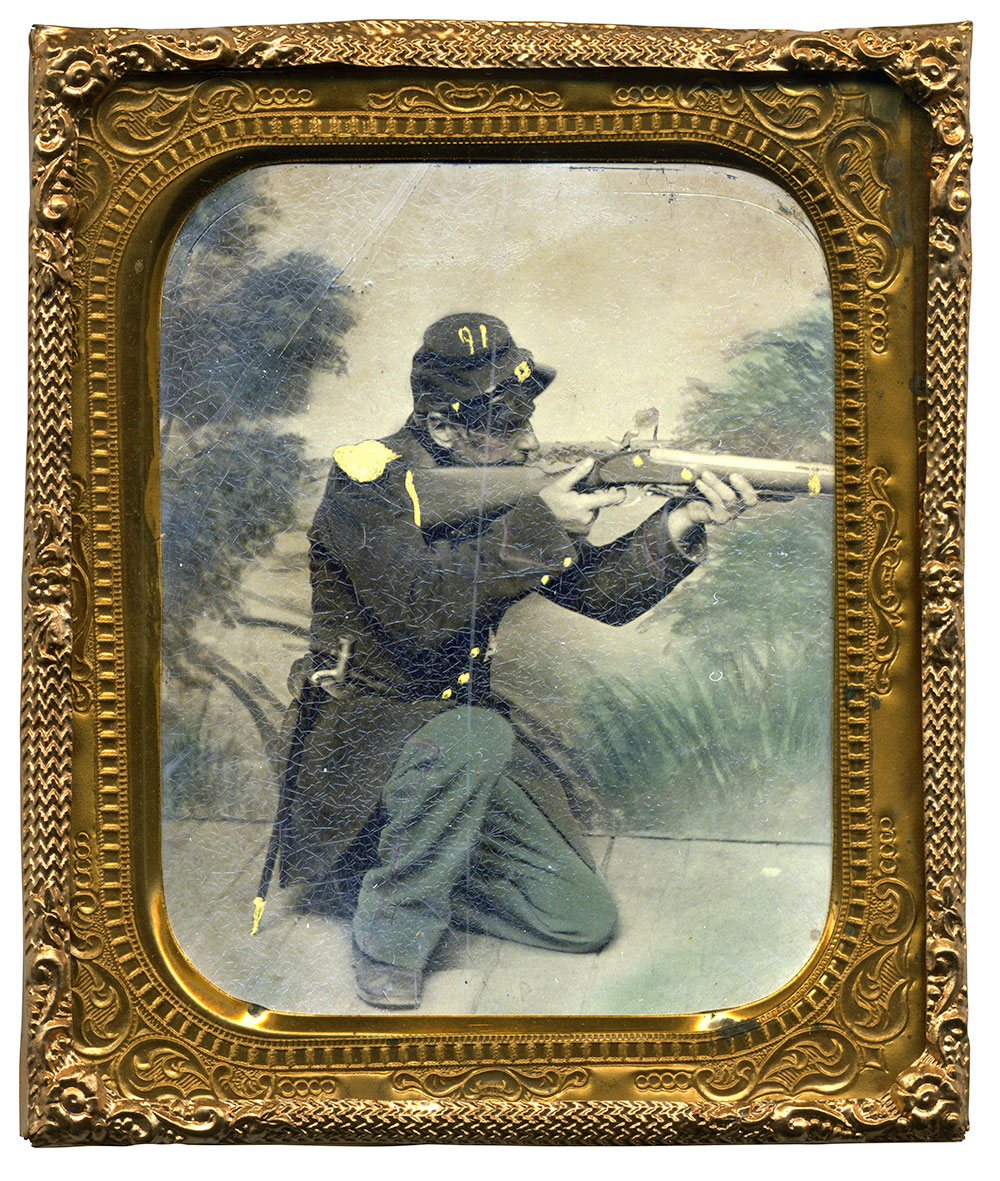
A Union soldier strikes the Fire and Load Kneeling position pictured in the 1863 U.S. Infantry Tactics manual. His cuff trim, tinted red, indicates he served in the artillery. The pose and hand-lettered 91 on his cap suggests he served as a heavy artilleryman from one of the more populous Northern states.
A Yankee and His Half-Stock
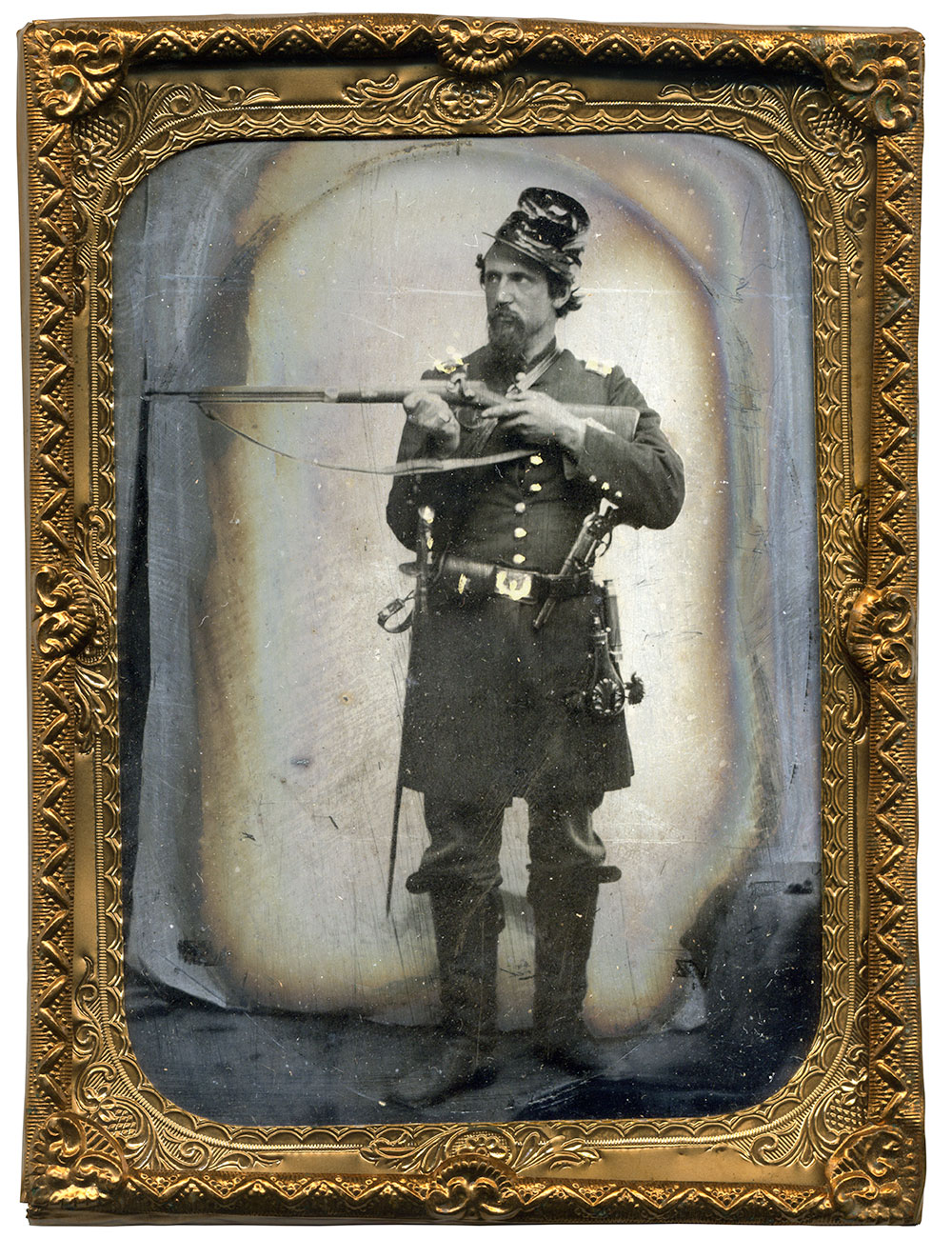
The half-stock percussion rifle held by this officer is of the type made popular by the Hawken brothers of St. Louis. The rifle’s presence suggests he may have served in a Western regiment. He is also equipped with a Starr revolver, 1850 Foot Officer’s sword, brass powder flask and spy glass.
Death in Trostle’s Woods
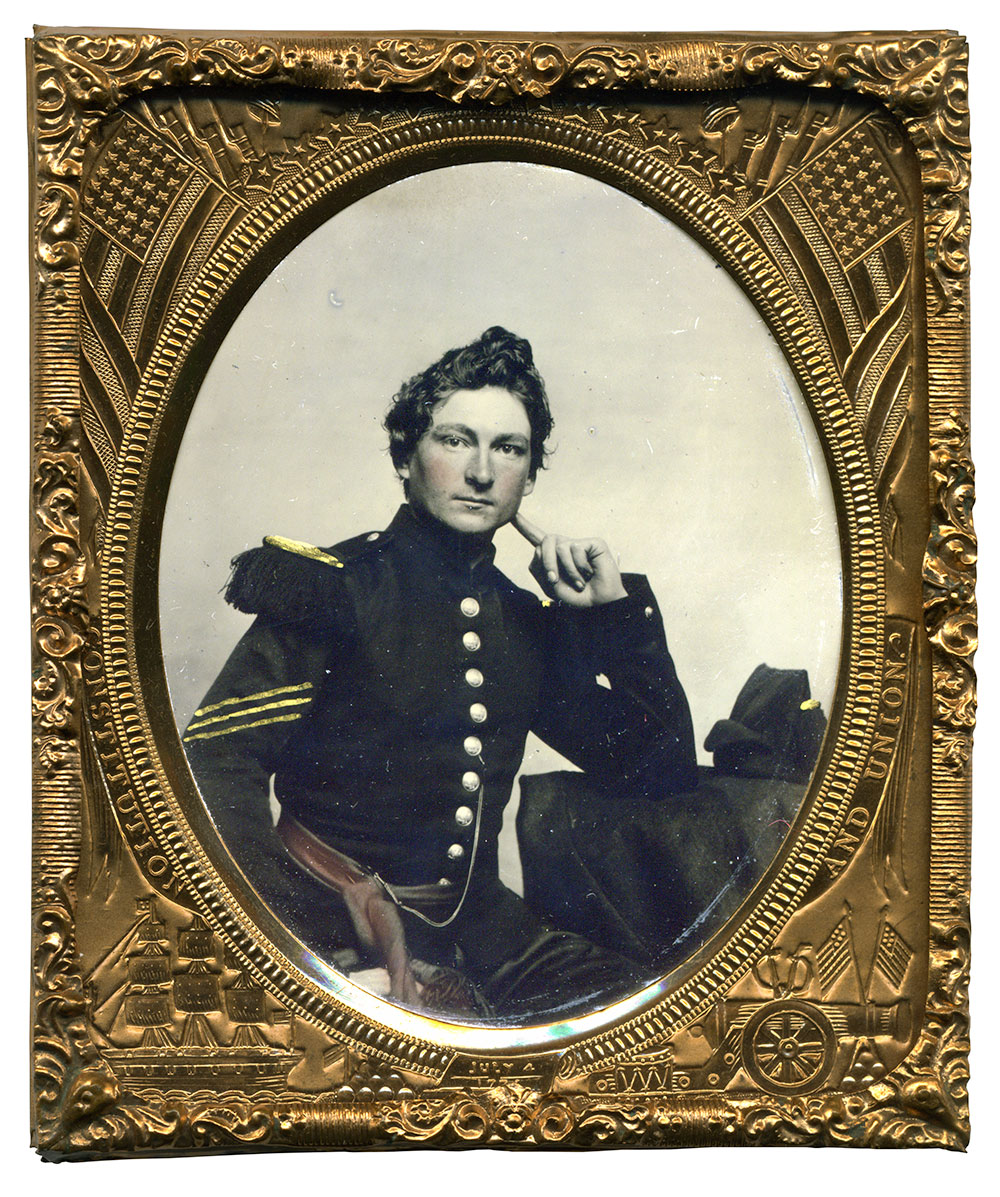
Stray shots peppered the officers and men of the 62nd Pennsylvania Infantry as they took up a position in the southern portion of Trostle’s Woods at Gettysburg on July 3, 1863. Some of the bullets struck with deadly accuracy, and among the victims was 1st Lt. Scott C. McDowell. A native of County Tyrone, Ireland, McDowell landed in America as a boy with his widowed mother, Annie, during the height of Ireland’s Great Famine. They settled in Pittsburgh. His death deprived Annie of her sole source of income, and she received a pension from the federal government to compensate the loss of her son. McDowell is pictured dressed in the Chausseur-style uniform of the regiment. He ranked as a sergeant in Company G at his enlistment in the summer of 1861.
SPREAD THE WORD: We encourage you to share this story on social media and elsewhere to educate and raise awareness. If you wish to use any image on this page for another purpose, please request permission.
LEARN MORE about Military Images, America’s only magazine dedicated to showcasing, interpreting and preserving Civil War portrait photography.
VISIT OUR STORE to subscribe, renew a subscription, and more.

